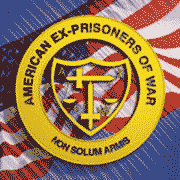
Established April 14, 1942
 |
American Ex-Prisoners of War
A not-for-profit, Congressionally-chartered veterans’ service organization advocating for former prisoners of war and their families.
Established April 14, 1942 |

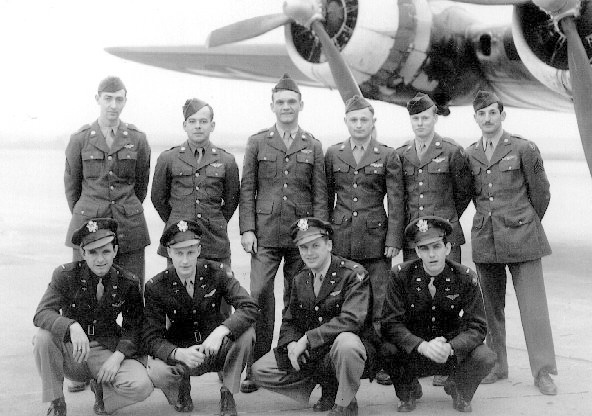
James H. Fisher Crew - 427th BS
photo: Ardmore, OK, Mar 1944) (Back L-R) S/Sgt August H. Johnson (E), Sgt Theo T. Montfort (G)(not on final crew), S/Sgt Donald K. Duncan (R-KIA), Sgt Joseph J. Tercek (RWG-KIA), Sgt Irving Bellitt (TG-KIA), unknown (Front L-R) 2Lt James H. Fisher (P-POW), F/O George W. Franzen (CP-KIA), 2Lt Harold F. Kauffman (N-KIA), 2Lt Parker (B- not on final crew) Missing in Action on 29 April 1944 on Mission #144 to Berlin, Germany after being hit by German fighters. |
||
| Last Name | First Name, Middle Init. | Nickname |
| Spouse | City | State, Zip |
| Conflict — Theatre | Branch of Service | Unit: |
| Military Job | Date Captured | Where Captured |
| Age at Capture | Time Interned | Camps |
| Date Liberated | Medals Received | |
| After the War ... | ||
After three milk-run missions, our fourth was to Berlin, on April 29, 1944. We were hit by flak between no. 3 and 4 engines and had to feather no. 4. We were unable to keep up with the formation but did continue over the target and dropped our bombs. Shortly after leaving the target we were attacked by ME 109s.
After being literally shot to pieces I gave the order to bail out; only two of us survived. I must assume that the rest of the crewmembers were killed by the withering fire from the ME 109s. I was wounded, probably fragments from the instrument panel after machine gun bullets shattered it. I was also roughed up by civilians on the ground in Hanover before German soldiers rescued me.
After a short stop at Dulag Luft near Frankfurt, I went to Stalag Luft III near Sagan and remained there until the night of January 28, 1944. We were marched out around midnight. After five days of marching in snow and freezing weather, we reached Spremburg; there we were loaded onto 40 and 8 boxcars for a trip to Nuremburg, arriving Feb. 5. There we were interned in Stalag XIII D.
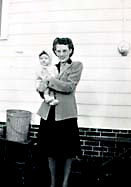
|
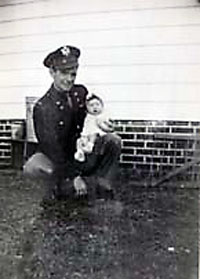
|
|
Doris and James H. Fisher Showing Off Baby Linda, 1943
|
|
My companion in the adventure, John Maksymic, and I were the first allied prisoners of war these American troops had encountered and they were taking no chances. They were all too aware of the kind of deadly tricks they could encounter from a desperate and resourceful enemy.
The story of how we got to that railroad trestle began when Stalag Luft III was evacuated in January, 1945. The group I marched out with eventually wound up at an abandoned Italian prison camp in Nuremburg. This camp was a far cry from Stalag Luft III; it had open bay sheds for barracks, filthy and loaded with bed bugs and every other kind of vermin known to mankind.
While we were there we had front row seats to some of the most spectacular sights I have ever seen. For 14 straight days the Americans bombed during the day and the British bombed at night. From our vantage point about two miles from the rail yards, we could see it all, and it was spectacular.
We felt relatively safe because the bomber crews knew where we were and we also had some concrete slit trenches that had been made for outdoor latrines but had never been used. Admittedly we were a little apprehensive during the first American daylight raid through a thick overcast -- we had never heard of radar-controlled bombing.
We had been at Nuremburg about two months when the rumors started that the Gestapo was going to hold all officer personnel as hostages to be used to bargain with when the time came from them to surrender, which everyone knew was not too far off. The rumor got more believable when we saw some of the men in their long black leather coats in the vorlager of the camp. Mac and I decided it was time to go, reasoning that we would rather die trying to escape than to take our chances with the Gestapo.
We picked a night when the British were bombing because on these nights all lights were out, including the sweeping searchlights on the guard towers. On the night of April 1st or thereabouts we managed to climb over the fences using a piece of siding from one of the latrines to walk over the coiled barbed wire between the fences.
It was after about three weeks of walking at night and sleeping during that day that we arrived at the point under the railroad trestle. During this 21-day trek we were recaptured once. We walked right into a German forward scout post. I guess the Germans were as surprised as we were, and for reasons known only to God, they didn't shoot us.
We were being marched back toward the interior by two German GIs, sleeping in barns at night and stopping for food along the way at farm houses in the country and at little home cooking cafes in the villages. It was while we were in one of these little cafes that Mac and I thought that our time had come. There was a sudden loud explosion and the building started collapsing around us. Needless to say, the Germans went one way and Mac and I went the other.
After we got out of the building we ran to a wooded area just outside of town and from there watched two P-51 Fighters strafe and destroy the little town with 50 caliber machine guns. The town was a motor pool and truck depot for the Germans, which they were out to destroy. And that they did, believe me!! It is only by the Grace of God that I am alive today. A few nights later we holed up under the railroad trestle and that was our ticket home.
The American scouting party we surrendered to marched us back to their headquarters with our hands held high and there we stayed in the custody of the Military Police while they check out our stories. In my case they contacted the 303rd Bomb Group in Molesworth, England who verified that Lt. James H. Fisher, Serial Number AO753783, a B-17 pilot, had been shot down on April 29, 1944, was reported captured by the Germans and held at Stalag Luft III. When Mac's story checked out too, they treated us royally.
After dining in their field kitchen on pork chops and cherry cobbler, we were given a little car that had been "field requisitioned" from a German civilian and were allowed to make our own way back. We were given directions to a field hospital where we were given a cursory physical.
While waiting at the hospital, we met two pilots of some kind of small airplane that could handle short-field landings and takeoffs. Their job was to pick up and return crew members of downed aircraft.
They took us to Brussels where they had a building with four apartments all to themselves. They had found the basement stacked with Seagram's 7-Crown, apparently left when the Germans evacuated. Three drinks and I passed out. While I was there I also had my first ice cream in more than a year. After we spent a day sightseeing in Brussels, they flew us to Paris, where we checked in with the American Command at Allied Headquarters.
After we received a $300 pay advance and a new outfit of clothing at the PX, we were allowed two days of sightseeing and entertainment, including the Follies. Then we proceeded to Camp Lucky Strike for the boat ride home.
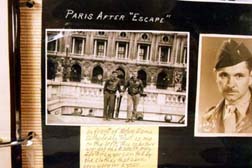
James Fisher and John Marker
|
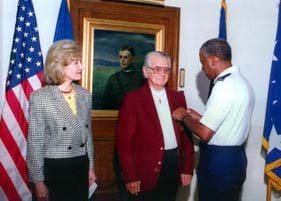 Presentation of Air Medal, Sept. 1, 1997
|
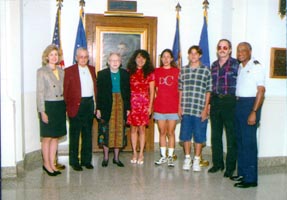 James Fisher, Sept. 1, 1997
|